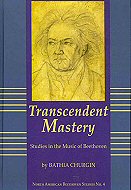|
Transcendent Mastery: Studies in the Music of Beethoven
|
|
Bathia Churgin
|

|

The purpose of the four long chapters in this volume is to consider widely and deeply four of Beethoven's most excellent works. Each work represents a different genre and each comes from a different period of Beethoven's stylistic development. Thus, the Piano Sonata, Op. 10, No. 3 (1797-98) represents the early period; the Violin Concerto, Op. 61 (1806), and Violin Sonata, Op. 96 (1812), the middle period (though with several later traits in Op. 96); and the String Quartet, Op. 132 (1825), the late period. In this way, the reader becomes acquainted with the special character of each genre as well as the overall development of Beethoven's style - including a large range of structural types and unique forms. Each work is given a comprehensive analysis rarely applied to single compositions of Beethoven.
Beyond the necessary historical background and references to the critical reception, comparisons have been included with other works by Beethoven in the same genre and period. This wider context combines with an effort to view Beethoven's music not only in terms of the heritage of Haydn and Mozart, but also in relation to the long development of Classic style and its procedures from the early Classic period onward, starting in the 1730s.[…]
The main emphasis in this book is on analysis of the music itself, analysis that reflects especially the approaches of Jan LaRue's Guidelines for Style Analysis (1970, 1992) and Leonard G. Ratner's basic survey Classic Music: Expression, Form, and Style (1980). The focus, therefore, is on Beethoven's treatment of the various musical elements: growth (formal aspects) , sound (including texture, dynamics, and timbre) harmony, melody, and rhythm.
A sixth element, expression, has been added with respect to conventional dance types and styles of the period […].
|
|
